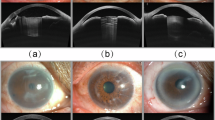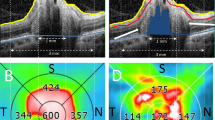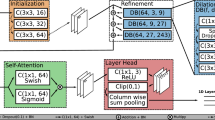Abstract
Purpose
To describe a new algorithm to measure corneal densitometry based on images obtained by swept source anterior segment ocular coherence tomography (SS-AS-OCT) and establish standard densitometry values in a group of normal eyes.
Methods
A total of 111 healthy participants (195 eyes) were enrolled in this study. Using a MATLAB designed algorithm, the cornea was segmented into three layers: anterior, posterior and mid-stroma, and it was divided into two concentric areas, 0–2 and 2–4 mm, resulting in nine areas for the analysis. The mean corneal densitometry values were calculated and expressed as grayscale units (GSU).
Results
The mean age was 57 years (range 22–87), with 100 (51.3%) right eyes and 95 (48.7%) left eyes. The total corneal densitometry was 86.9 ± 12.1 GSU. The mid-stroma layer had the highest densitometry values, 87.4 ± 12.1 GSU, and the anterior layer had the lowest values, 81.9 ± 14.2 GSU. Densitometry differences between the anterior layer and the mid-stroma layer (P < 0.001), as well as the anterior layer and the posterior layer (P < 0.05) were statistically significant. The 0–2 mm concentric area had higher mean densitometry values, 97.8 ± 12.7 GSU, and the differences were significant compared to the 2–4 mm concentric area (P < 0.001). No correlation was found between the corneal densitometry values and gender or age.
Conclusions
The new MATLAB segmentation algorithm for the analysis of corneal SS-AS-OCT images is capable to objectively assess corneal densitometry. We provide standard and normal data for better clinical and research approach.
Similar content being viewed by others
Login or create a free account to read this content
Gain free access to this article, as well as selected content from this journal and more on nature.com
or
References
Otri AM, Fares U, Al-Aqaba MA, Dua HS. Corneal densitometry as an indicator of corneal health. Ophthalmology. 2012;119:501–8.
Ha BJ, Kim TI, Choi SI, Stulting RD, Lee DH, Cho HS, et al. Mitomycin C does not inhibit exacerbation of granular Corneal dystrophy type ii induced by refractive surface ablation. Cornea. 2010;29:490–6.
Elflein HM, Hofherr T, Berisha-Ramadani F, Weyer V, Lampe C, Beck M, et al. Measuring corneal clouding in patients suffering from Mucopolysaccharidosis with the Pentacam densitometry programme. Br J Ophthalmol. 2013;97:829–33.
Greenstein SA, Fry KL, Bhatt J, Hersh PS. Natural history of Corneal haze after collagen crosslinking for keratoconus and corneal ectasia: Scheimpflug and biomicroscopic analysis. J Cataract Refract Surg. 2010;36:2105–14.
Gutierrez R, Lopez I, Villa-Collar C, Gonzalez-Meijome JM. Corneal transparency after cross-linking for keratoconus: 1-year follow-up. J Refract Surg. 2012;28:781–6.
Kikkawa Y, Hirayama K. Uneven swelling of the corneal stroma. Investig Ophthalmol. 1970;9:735–41.
Allemann N, Chamon W, Silverman RH, Azar DT, Reinstein DZ, Stark WJ, et al. High-frequency ultrasound quantitative analyses of corneal scarring following excimer laser keratectomy. Arch Ophthalmol. 1993;111:968–73.
Møller-Pedersen T, Cavanagh HD, Petroll WM, Jester JV. Corneal haze development after PRK is regulated by volume of stromal tissue removal. Cornea. 1998;17:627–39. https://doi.org/10.1097/00003226-199811000-00011.
Møller-Pedersen T, Vogel M, Li HF, Petroll WM, Cavanagh HD, Jester JV. Quantification of stromal thinning, epithelial thickness, and corneal haze after photorefractive keratectomy using in vivo confocal microscopy. Ophthalmology. 1997;104:360–8. https://doi.org/10.1016/s0161-6420(97)30307-8.
Binder PS, Bosem M, Weinreb RN. Scheimpflug anterior segment photography assessment of wound healing after myopic excimer laser photorefractive keratectomy. J Cataract Refract Surg. 1996;22:205–12.
Wang J, Simpson TL, Fonn D. Objective measurements of corneal light-backscatter during corneal swelling, by optical coherence tomography. Investig Ophthalmol Vis Sci. 2004;45:3493–8.
Hillenaar T, Cals RH, Eilers PH, Wubbels RJ, van Cleynenbreugel H, Remeijer L. Normative database for corneal backscatter analysis by in vivo confocal microscopy. Investig Ophthalmol Vis Sci. 2011;52:7274–81.
Patel S, Winter EJ, McLaren JW, Bourne WM. Objective measurement of backscattered light from the anterior and posterior cornea in vivo. Investig Ophthalmol Vis Sci. 2007;48:166–72.
Ní Dhubhghaill S, Rozema JJ, Jongenelen S, Ruiz Hidalgo I, Zakaria N, Tassignon MJ. Normative values for corneal densitometry analysis by Scheimpflug optical assessment. Investig Ophthalmol Vis Sci. 2014;55:162–8. https://doi.org/10.1167/iovs.13-13236.
Potsaid B, Baumann B, Huang D, et al. Ultrahigh speed 1050nm swept source/Fourier ___domain OCT retinal and anterior segment imaging at 100,000 to 400,000 axial scans per second. Opt Express. 2010;18:20029–48. https://doi.org/10.1364/OE.18.020029.
Wang J, Fonn D, Simpson TL, Sorbara L, Kort R, Jones L. Topographical thickness of the epithelium and total cornea after overnight wear of reverse-geometry rigid contact lenses for myopia reduction. Investig Ophthalmol Vis Sci. 2003;44:4742–6.
Zhang T, Elazab A, Wang X, Jia F, Wu J, Li G, et al. A novel technique for robust and fast segmentation of corneal layer interfaces based on spectral-___domain optical coherence tomography imaging. IEEE Access. 2017;5:10352–63.
Johnson DH, Bourne WM, Campbell RJ. The ultrastructure of Descemet’s membrane. I. Changes with age in normal corneas. Arch Ophthalmol. 1982;100:1942–7. https://doi.org/10.1001/archopht.1982.01030040922011.
Tekin K, Sekeroglu MA, Kiziltoprak H, Yilmazbas P. Corneal densitometry in healthy corneas and its correlation with endothelial morphometry. Cornea. 2017;36:1336–42. https://doi.org/10.1097/ICO.0000000000001363.
Vasudevan B, Simpson TL, Sivak JG. Regional variation in the refractive-index of the bovine and human cornea. Optom Vis Sci. 2008;85:977–81. https://doi.org/10.1097/OPX.0b013e3181886fa5.
Komai Y, Ushiki T. The three-dimensional organization of collagen fibrils in the human cornea and sclera. Investig Ophthalmol Vis Sci. 1991;32:2244–58.
Patel S, McLaren J, Hodge D, Bourne W. Normal human keratocyte density and corneal thickness measurement by using confocal microscopy in vivo. Investig Ophthalmol Vis Sci. 2001;42:333–9.
Hahnel C, Somodi S, Weiss DG, Guthoff RF. The keratocyte network of human cornea: a three-dimensional study using confocal laser scanning fluorescence microscopy. Cornea. 2000;19:185–93.
Prydal JI, Franc F, Dilly PN, Kerr Muir MG, Corbett MC, Marshall J. Keratocyte density and size in conscious humans by digital image analysis of confocal images. Am J Optom Physiol Opt. 1998;12:337–42.
Ruberti JW, Roy AS, Roberts CJ. Corneal biomechanics and biomaterials. Ann Rev Biomed Eng. 2011;13:269–95.
Smith GT, Brown NA, Shun-Shin GA. Light scatter from the central human cornea. Eye. 1990;4:584–8. https://doi.org/10.1038/eye.1990.81.
Rozema JJ, Trau R, Verbruggen KH, Tassignon MJ. Backscattered light from the cornea before and after laser-assisted subepithelial keratectomy for myopia. J Cataract Refract Surg. 2011;37:1648–54. https://doi.org/10.1016/j.jcrs.2011.03.043.
Garzón N, Poyales F, Illarramendi I, Mendicute J, Jáñez Ó, Caro P, et al. Corneal densitometry and its correlation with age, pachymetry, corneal curvature, and refraction. Int Ophthalmol. 2017;37:1263–8. https://doi.org/10.1007/s10792-016-0397-y.
Olsen T. Light scattering from the human cornea. Investig Ophthalmol Vis Sci. 1982;23:81–6.
Acknowledgements
The authors assume full responsibility for the analyses and interpretation of these data.
Author information
Authors and Affiliations
Contributions
XYW and JP-N were responsible for conceiving the presented idea. XYW, JP-N, IBD and CRdL carried out the experiments. XYW and TQZ performed the computations. XYW and JP-N wrote the manuscript with the support from JP-N, IB-D, CR-d-L and ARR. Author AMA-C supervised the project. All authors provided critical feedback and helped shape the research, analysis and manuscript.
Corresponding author
Ethics declarations
Competing interests
The authors declare no competing interests.
Additional information
Publisher’s note Springer Nature remains neutral with regard to jurisdictional claims in published maps and institutional affiliations.
Rights and permissions
About this article
Cite this article
Wang, X.Y., Zhang, T.Q., Rachwani, A.R. et al. New algorithm for corneal densitometry assessment based on anterior segment optical coherence tomography. Eye 36, 1675–1680 (2022). https://doi.org/10.1038/s41433-021-01707-7
Received:
Revised:
Accepted:
Published:
Issue Date:
DOI: https://doi.org/10.1038/s41433-021-01707-7
This article is cited by
-
MCOA: A Comprehensive Multimodal Dataset for Advancing Deep Learning in Corneal Opacity Assessment
Scientific Data (2025)
-
Quantitative evaluation of corneal irregularity and scarring after infectious keratitis using anterior segment optical coherence tomography
Graefe's Archive for Clinical and Experimental Ophthalmology (2024)
-
The intra- and inter-day repeatability of corneal densitometry measurements in subjects with keratoconus and in healthy controls
Scientific Reports (2023)



